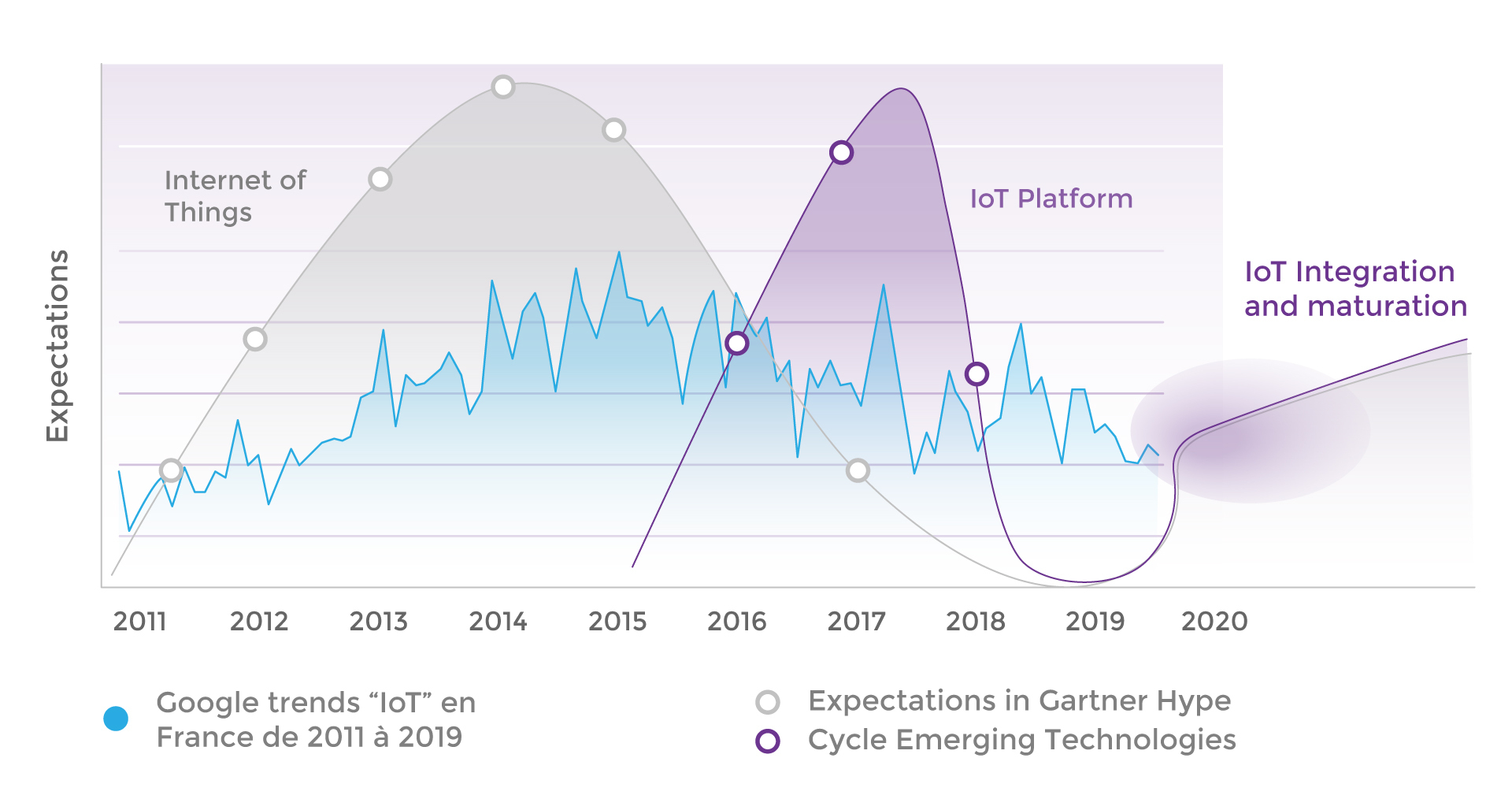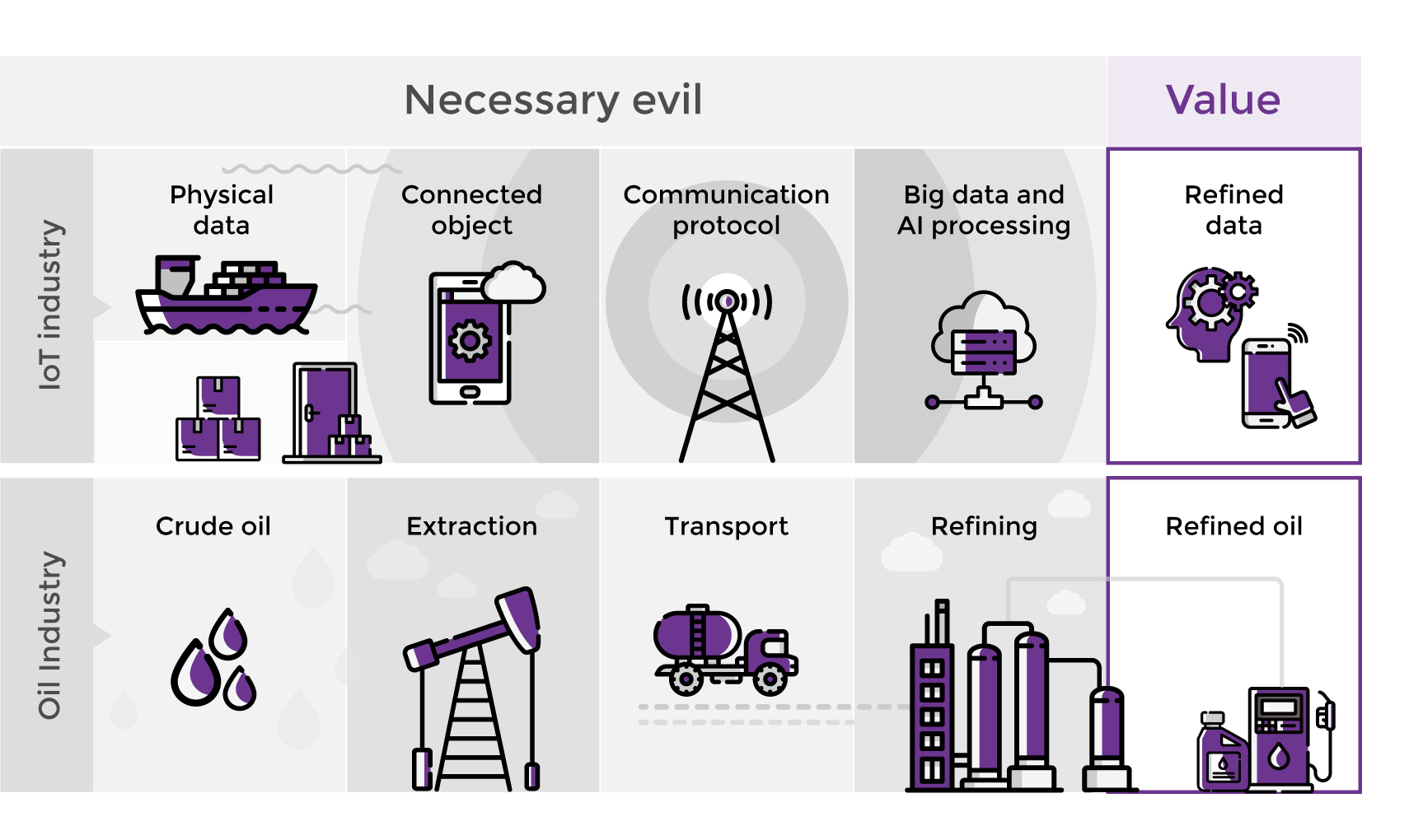IoT : Secret of the gods
While it’s true that the media hype around the term ‘Internet of Things’ has been beneficial for ...
While it’s true that the media hype around the term ‘Internet of Things’ has been beneficial for ...
The smart building is in the process of transforming the construction industry. Thanks to ...
Within a company, any instance of large-scale IoT deployment will begin with a test phase. This ...

While it’s true that the media hype around the term ‘Internet of Things’ has been beneficial for the visibility of the users of these technologies, the term remains overused because its purpose is misunderstood.
It is both awkwardly employed because of the numerous usages that are wrongly attributed to it (incorrect consumer usages) and unnecessarily disparaged and manipulated by its detractors. (we are still witnessing age-old debates on communication protocols, while the focus should be on the cost of data extraction and collection). It is therefore deprived of its business value.
The objective of this article is to focus on a pragmatic approach to the IoT (Internet of Things) in order to grasp the real, related economic stakes. Finally, because it is primarily an industrial approach, we reveal one of the secrets of the gods : the economic equation of an IoT project.
Let’s start with a simple and effective definition: the IoT refers to the gathering of data from the physical world (our environment, an industrial process, etc.) to better understand and optimise it. Henceforth, IoT refers directly to the capturing of data from the environment, whether or not created by Man (noise, heat, humidity, vibrations, etc.), with the objective of harnessing them.
« The IoT refers to fundamental goals and a shared vision. Whether we’re talking about home automation, Smart Home, Machine to Machine, or IoT, we find the longstanding fantasy of being human is to extend his grip on the physical world. Rendering us << masters and possessors of nature >>, as Descartes sensed. » (Ludovic Le Moan - ZERO G)
Separating the cases of B2B (Business to business) and B2C (Business to consumers) usages is commonly accepted. The industrial use cases are generally intended to improve business processes of companies with associated profitability calculations, while the B2C (Business to consumers) approach still remains “gadgetised”, notably with “consumer” portable technologies, such as watches or connected personal scales.
We will continue with a trivial example, but concrete, to illustrate what an IoT BtoB use case can be.
To optimise the energy performance of meeting rooms, we could harvest data issued by connected thermometers and motion detectors, all physically located within the offices. It is then easy to imagine the benefits of cross-referencing these data : interpreting their co-evolution permits the rationalisation of energy costs to the concerned buildings. If the temperature of the meeting rooms rises even though there is no-one inside, the heating will be extended to save energy thanks to the thermometer that uploads this information to the cloud, and the empty meeting rooms would be made available to other employees who would be notified of their availability. In this example, electricity bills and the fluidity of the buildings would be optimised thanks to the IoT.
Today, it seems that we have achieved a new cycle within the development of the IoT. After experiencing the inflation of expectations in 2013-2015 and ensuing disillusionment in 2017-2018, the maturity period of the industrial IoT is currently taking place, if we are to believe Google semantic trends and the studies of Gartner.
Below is a superposition of two trends:

The reasons for this maturation of the industrial IoT resides in an approach purely ROIste (ROI = return on investment) as opposed to the gadgetised “general public” approaches.
On the one hand, because the IoT necessitates vast deployments with many connected objects to be profitable, it is frequently associated with economies of scale. For industrialists, scale effects refer to the reduction in the unit cost of a product obtained by increasing the quantity of production. In other terms, the more connected objects are produced and deployed in vast numbers (trackers, buttons etc.), the less they cost to produce and deploy. Their massive deployments can be correlated to an exponential growth of the data collected, and therefore of the value to be harnessed.
On the other hand, if a large-scale IoT investment project is going to see the light of day, it is obvious that it must be assessed on the basis of a cost-benefit evaluation of the data acquisition, depending on the use case under consideration. This fundamental economic principle is known and managed by the industrialists because behind each collected data point, there is a business model to be examined and understood in-depth.
And the end of the day, the unique question of which a client must respond is that of the cost of extraction and the collection of data, at which scale and which life cycle of the project, and of which level of service is expected? ( IoT Business News - January 2020 )
The IoT follows a similar logic to that of the oil industry : whether one collects billions of data points or billions of drops of oil, the question of the cost of extraction remains crucial because it determines the price at which the latter can be sold.
Like the oil industry, where crude oil is extracted underground, transported by pipelines or trucks, refined in oil or diesel and finally consumed in our cars or processed into polymers, it’s uniquely the value added that pays in the IoT. This economy is worth billions.
In other words, connecting an object to the cloud is a necessary evil for obtaining the data but is by no means an end in itself. The purpose lies in the use of the data.

If we wish to know the temperature outside, one must have a thermometer. But in the end, what interests us is obtaining this data at the best cost within a determined period, not the thermometer (unless it’s decorative and makes your home pretty). The object is therefore a necessary evil to obtain the data.
If we wish to transfer vibration data from an industrial machine to the cloud via a communication protocol to anticipate potential malfunctions, we need the necessary infrastructure. But in the end, what interests us, is obtaining the data at the best cost within a determined period, not the communication protocol. Once again, the protocol is therefore a necessary evil for obtaining the data.
Logically, approaches centered around sensors or protocols are therefore wrong and have to focus on the cost of data acquisition in relation to the specific use case.
The cost of data acquisition depends on both the cost of the object fabrication in volume and the autonomy of the produced object (the more an object communicates, the quicker the battery will run down, and the higher the costs on interventions of these objects will be). Therefore, depreciation and valuation calculations must take into account the costs of interventions on the objects weighted by the number of years.
In other words, in the data cost equation, the autonomy of an object is generally one of the most important factors along with the desired service rate and the safety of the object.
We can therefore explain the data equation by : the cost of extraction (price of the object in volume) the cost of transferring the data to the cloud (protocols) and the autonomy of the object (amortization and intervention costs)
The IoT is above all a rational approach that we can apply thanks to a simple equation.Let’s take the example of waste collection : we can estimate the value of the data “filling rate” (Tx) with the parameters (a, b, c, d…) by an equation in the following form :
Tx = a * Pc + b * TxH + c * PCO2 + d * PeV + ...
Pc = fuel prices
ThX : staff hourly rate
PCO2 = price per tonne of CO2 generated
PeV = vehicle maintenance cost per kilometer
By definition, this equation gives us a fairly good approximation of the cost of the collected data as a function of the sum of parameters influencing the minimum value of the data (the parameters here are : the price of fuel, staff hourly rate etc.). Ultimately this permits us to know whether or not collecting the data is economically viable.
Clearly, this approach has the merit of maximising the value of the data and aiming at a marginal cost of 0 for each data point collected (Cf. Jeremy Rifkin - Economist and author of the book “The Zero Marginal Cost Society” 2016).
However, this equation could be refined and supplemented by experts and specialists within the domain of waste collection, public policy experts, transport, but above all else data specialists who could contribute to the approximation of the expected benefit.
In conclusion, we have presented to you what is the “Holy Grail of the IoT”. Knowing the cost of data acquisition is based on a multi-factorial equation that everyone must know in order to control a project from start to finish. It is this fundamental exercise that must be learned or re-learned in order to benefit from what the IoT really is.
231, Rue Pierre et Marie Curie
31670 Labège
France
+33 05 82 08 07 87